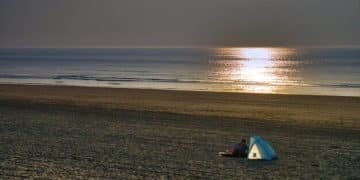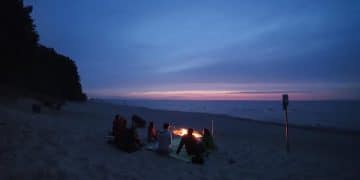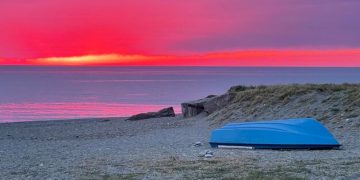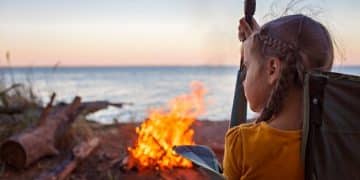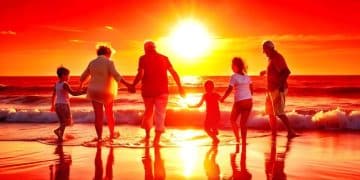Beach Camping 101: Your Guide to Sleeping Under the Stars
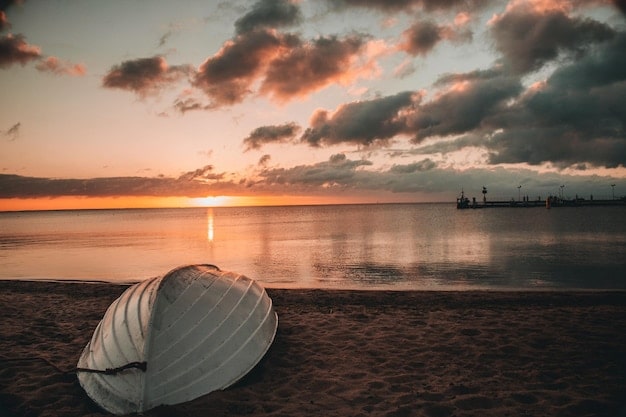
Beach Camping 101: A Beginner’s Guide to Sleeping Under the Stars offers essential tips on gear selection, campsite setup, safety practices, and environmental responsibility, ensuring a memorable and safe beach camping experience.
Dreaming of falling asleep to the sound of waves? Beach Camping 101: A Beginner’s Guide to Sleeping Under the Stars is your first step to making that dream a reality. Let’s pitch that tent!
Choosing the Right Beach Camping Gear
Picking the correct equipment is vital for a successful and comfortable beach camping trip. From tents to sleeping bags, each item plays a crucial role in ensuring you have a pleasant experience.
Selecting a Suitable Tent
Your tent will be your shelter, so choose wisely. Look for tents that are durable, weather-resistant, and easy to set up.
Comfortable Sleeping Arrangements
Don’t underestimate the importance of a good night’s sleep. A quality sleeping bag and a comfortable sleeping pad are essential for staying warm and cozy.
- Sleeping Bag: Opt for a bag rated for temperatures slightly lower than what you expect.
- Sleeping Pad: Inflatable pads offer better insulation and comfort compared to closed-cell foam pads.
- Pillow: A small, inflatable pillow can make a big difference in your sleep quality.
Having the right gear sets the foundation for enjoying the outdoors comfortably and safely. Investing in quality items guarantees that your focus remains on the sights and sounds, making your beach camping a relaxing experience.
Finding the Perfect Beach Campsite
The location of your campsite can significantly impact your overall beach camping experience. Consider factors like proximity to water, shelter from wind, and accessibility to amenities.
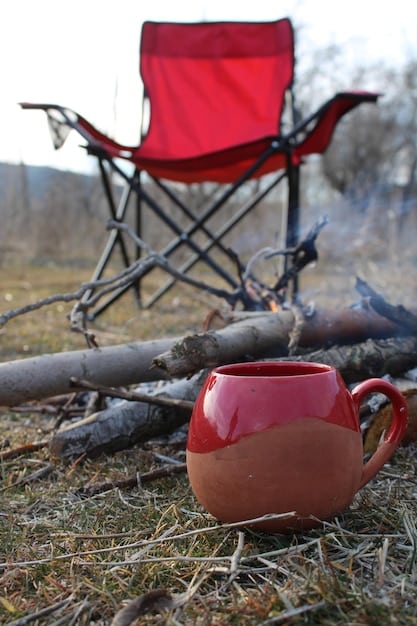
Assessing Beach Topography
Understanding the beach topography is essential for choosing a safe and comfortable spot. Avoid areas prone to flooding during high tide or those with unstable sand.
Considering Wind and Sun Exposure
Beaches can be windy places, and the sun can be intense. Look for natural windbreaks or shaded areas to protect yourself and your equipment.
- Windbreaks: Dunes, vegetation, or rock formations can offer protection from harsh winds.
- Sun Exposure: Morning sun is pleasant, but afternoon sun can be brutal. Choose a spot that allows for some shade.
- Tidal Patterns: Familiarize yourself with local tidal charts to avoid setting up camp in a potentially flooded area.
Finding the perfect spot involves considering various environmental factors to ensure both comfort and safety for a peaceful beach camping experience. Proper assessment guarantees worry-free nights by the ocean.
Setting Up Camp Safely and Efficiently
Setting up your campsite properly is crucial for both comfort and safety. A well-organized campsite can make your beach camping experience much more enjoyable.
Securing Your Tent
Beaches are often windy, so securing your tent properly is essential. Use sturdy stakes and guy lines to keep your tent grounded.
Organizing Your Campsite
A well-organized campsite is a happy campsite. Keep your gear tidy and easily accessible to make your stay more pleasant.
- Stake Placement: Angle your stakes into the sand for better grip, and use sandbags for added security.
- Gear Organization: Use storage bins, duffel bags, and hanging organizers to keep your campsite tidy.
- Camp Kitchen: Set up a designated cooking area away from your tent to minimize fire hazards and food odors.
Efficient setup enhances both safety and convenience, letting you fully appreciate the beach camping experience. Organization translates to hassle-free days and more time spent enjoying the scenery.
Cooking and Food Storage Tips
Properly managing your food and cooking setup is important for a comfortable and enjoyable beach camping trip. Thoughtful planning assures meals are easy and free from unwanted critters.
Preparing Meals
Plan your meals ahead of time and pack ingredients that are easy to prepare. Simple recipes and lightweight cooking equipment can make meal times a breeze.
Safe Food Storage
Keep your food safe from wildlife and the elements by storing it properly. Use airtight containers and coolers to keep food fresh and secure.

- Meal Planning: Choose one-pot meals, pre-chopped vegetables, and dehydrated foods to simplify cooking.
- Cooler Management: Use ice packs or frozen water bottles to keep your cooler cold, and drain melted ice regularly.
- Bear-Resistant Containers: If camping in an area with bears, use bear-resistant containers to store your food.
Efficient cooking plans and smart storage solutions translate to easier mealtimes and reduce the risk of attracting animals, guaranteeing a more enjoyable, stress-free outdoor experience.
Staying Safe on the Beach
Beach camping can be incredibly rewarding, but it’s essential to be aware of potential hazards and take necessary precautions to ensure your safety.
Understanding Beach Hazards
Beaches present unique hazards, such as strong currents, jellyfish, and sharp shells. Educate yourself about these risks and take steps to avoid them.
Protecting Yourself from the Elements
The sun, wind, and water can all pose risks. Wear appropriate clothing, use sunscreen, and stay hydrated to protect yourself from the elements.
- Sun Protection: Apply sunscreen liberally and reapply every two hours, especially during peak sun hours.
- Hydration: Drink plenty of water throughout the day to stay hydrated, and avoid sugary drinks that can dehydrate you.
- First Aid Kit: Carry a well-stocked first aid kit and know how to use it in case of minor injuries or emergencies.
Staying aware of these challenges and implementing precautions not only ensures physical well-being but also enhances peace of mind, allowing you to fully revel in the natural beauty and tranquility of beach camping.
Leave No Trace: Beach Camping Etiquette
Preserving the natural beauty of our beaches is everyone’s responsibility. Practicing Leave No Trace principles helps minimize our impact on the environment and ensures future generations can enjoy these pristine landscapes.
Packing Out All Trash
One of the most important Leave No Trace principles is packing out everything you pack in. This includes food wrappers, bottles, and any other trash you generate.
Minimizing Campfire Impact
If campfires are permitted, use existing fire rings or portable fire pits to minimize impact on the surrounding vegetation and soil.
- Pack It In, Pack It Out: Carry all your trash, food scraps, and waste back with you.
- Minimize Campfire Use: Use a camp stove for cooking whenever possible, and keep campfires small and contained.
- Respect Wildlife: Observe wildlife from a distance, and never feed animals, which can disrupt their natural behaviors.
Embracing these practices shows respect towards nature and guarantees that our actions today do not compromise the scenic beauty and ecological health for those who come after us. It ensures long-term sustainability in outdoor recreation.
Conclusion
Beach Camping 101: A Beginner’s Guide to Sleeping Under the Stars offers a unique blend of relaxation and adventure. With these guidelines, you’re well-prepared to embrace the sand, sea, and stars safely and responsibly.
| Key Aspect | Brief Description |
|---|---|
| ⛺ Gear Selection | Choose weather-resistant tents and comfortable sleeping gear. |
| 🏖️ Campsite Location | Assess beach topography and consider wind and sun exposure. |
| 🍳 Food & Cooking | Plan meals and store food safely in airtight containers. |
| 🌊 Beach Safety | Understand beach hazards and protect yourself from the elements. |
Frequently Asked Questions
▼
The best time for beach camping is during the shoulder seasons (spring and fall) when the weather is mild, and the crowds are smaller. Summer can be hot, and beaches can be crowded.
▼
Secure your tent with sturdy stakes angled into the sand. Use guy lines for extra stability, and consider pitching your tent behind natural windbreaks like dunes or vegetation to reduce wind exposure.
▼
Use insect repellent containing DEET or picaridin. Citronella candles or torches can also help keep mosquitoes and other bugs away. Keep your campsite clean and avoid leaving food out.
▼
Store your electronics in waterproof bags or containers to protect them from sand and water. Avoid using electronics near the water, and keep them in a safe, dry place when not in use.
▼
Essential items include a weather-resistant tent, comfortable sleeping bag and pad, sunscreen, insect repellent, a first aid kit, a portable stove, and plenty of water. Don’t forget a flashlight or headlamp!
Conclusion
Beach camping provides a unique escape, merging the serenity of nature with the thrill of adventure. By following this guide, you will certainly have an enjoyable trip.
